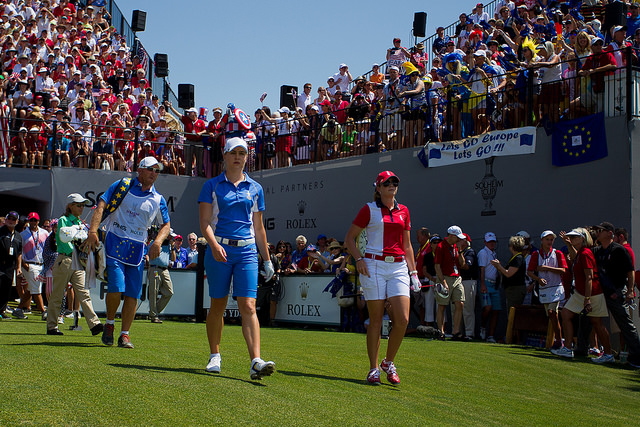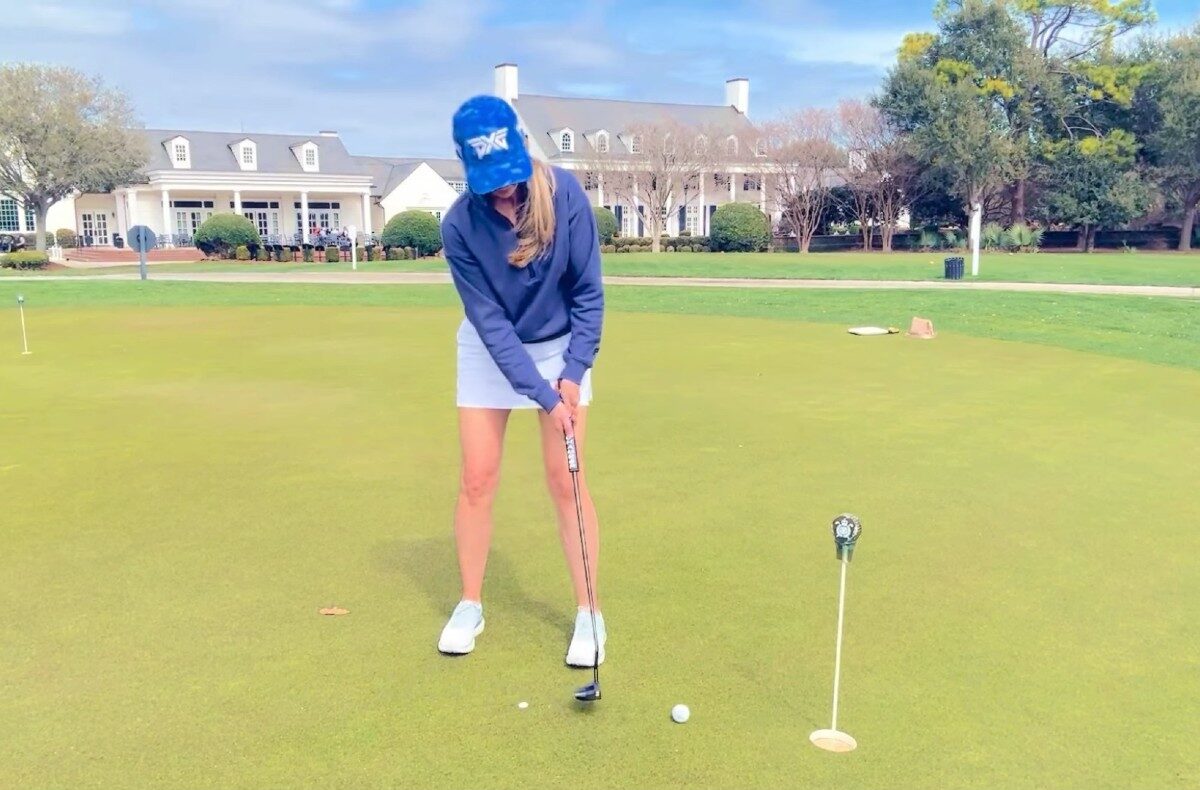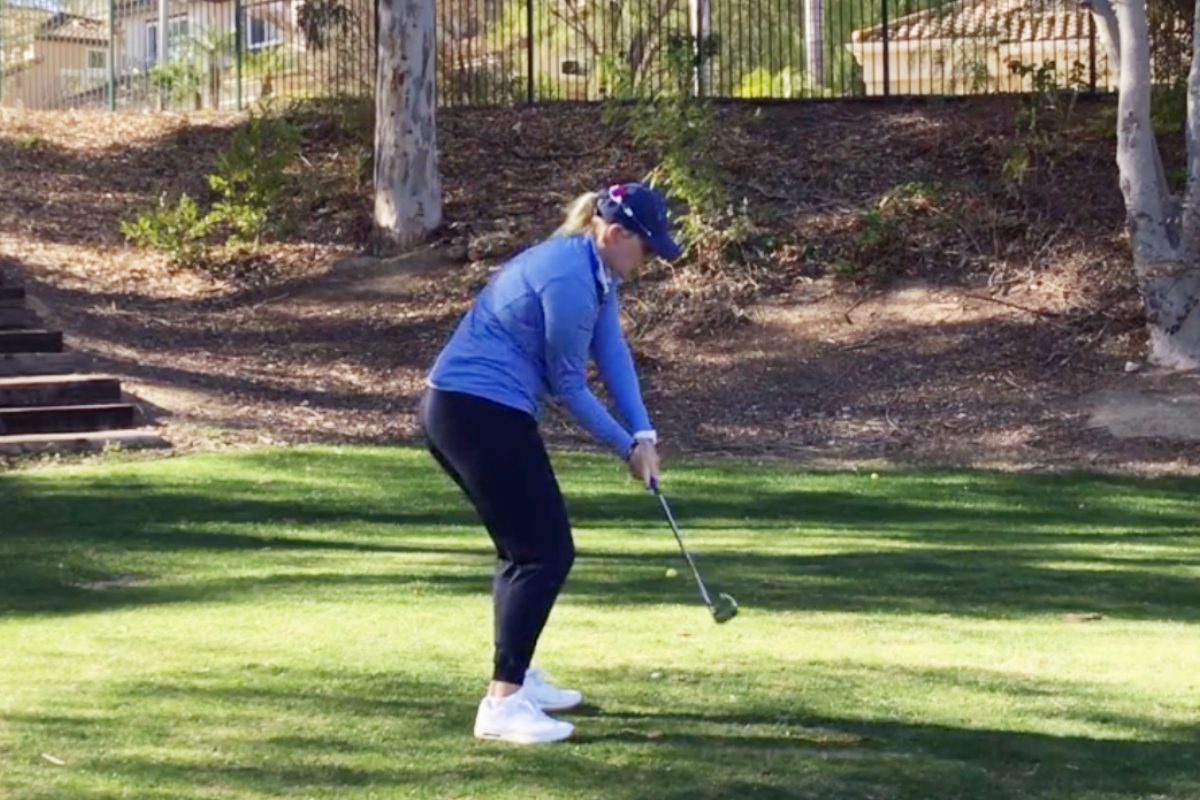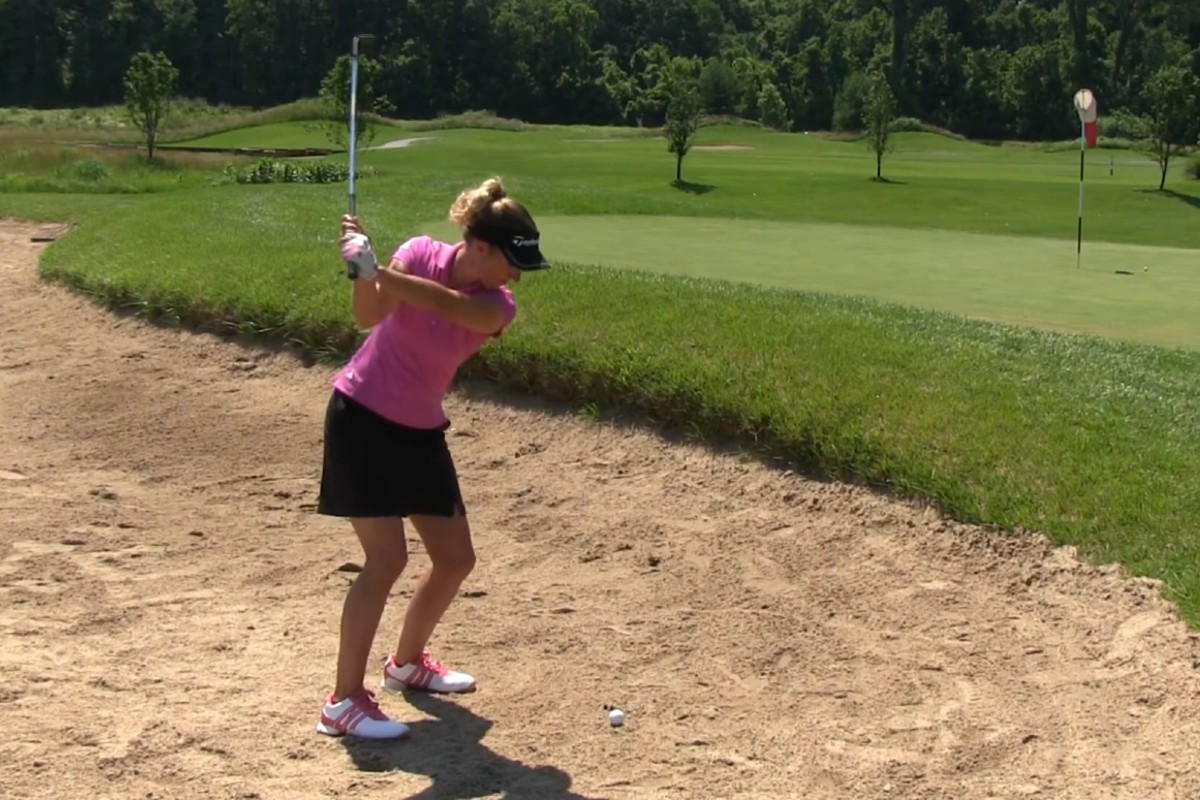By Nancy Berkley with Dr. Patricia Donnelly.
After listening to the Solheim Cup Team Europe and Team USA Captains explain their “Captain’s Picks” for their respective teams back on August 24th and 25th, I noticed how both Captains referred to several player’s skills at match play. Hmmm?? I wondered to myself. Are players born with a “match play” gene – like being a good painter or scientist? Or, is it a skill that can be coached? (To understand more about match play at the Solheim Cup see Match Play or Stroke Play – What Do You Like? and Almost Everything You Need to Know about the Solheim Cup.)
I was lucky because I knew just the person who could answer my question about coaching for match play – Dr. Patricia Donnelly, a sports psychotherapist. I met Patricia at a golf conference quite a few years ago. Patricia and I have remained friends over the years and periodically bounce ideas off each other about women’s golf.
So, I asked Patricia about coaching for match play. Of course, every golf teacher and coach might disagree or use a different approach. But here are my questions and Patricia’s answers:

What are the skills that match players have?
Great match players, like Bobby Jones (who won five U.S. Amateurs and one British Amateur, all at match play), understand that even though they are playing against an individual, they’re really still playing against the course. Jones always played against “Old Man Par,” as he called it, and that was usually good enough to beat his opponents. You don’t want to get caught up in worrying about who you’re playing, or how good she is. That can distract you from playing your normal game. Just play your game against the course. Of course, you have to be smart about it. When your opponent hits a tee shot ‘OB’ – out of bounds, you can then play a more conservative tee shot. Or if you just need to two-putt from 10 feet to win the hole, you don’t try to make the first putt and risk three-putting. So good match players stay calm and keep their wits about them, especially in pressure situations.
Are those skills innate or can they be learned? How might a Solheim Cup Captain-coach a player to develop those skills?
Although some players seem to have a more natural sense of how to play in match play, like ‘sparkplug’ Caroline Hedwall of Sweden, match play skills can be taught. One technique is to replicate match play situations in practice rounds. For example: Players practice lag putting and practice firing at the flag over tucked pins with shorter irons. A good coach teaches good strategy. For example, if a player is laying up on a hole, better to pick a conservative target and make an aggressive swing (not vice versa). I think it is good advice for players to keep their ball in play on every hole. Eventually, their opponent will start making mistakes. This thinking can be taught.
It’s reported that the St. Leon-Rot course for the Solheim Cup will be set up for birdies. Long hitters will be able to reach the green in a position to make a birdie putt and win the hole. That’s pressure, isn’t it? Can you coach a player for putting under pressure?

Especially with the course set up for lots of birdies, the putting will be even more important than usual. Putting for a birdie, or an eagle isn’t necessarily more difficult than putting for par. Players at this level should be able to focus on the stroke. Although they will have a keen awareness of the score when they are over the ball, they should be able to put that aside and concentrate on the putt. That is one area of the mental game where top professionals are different from most amateurs. They, however, will feel the tension. In this instance they are not different from amateur players; they are human. The big difference – and here is where they are different from amateurs – is that the players who excel at match play can channel their tension into good—winning—shots and putts. Tension is not necessarily a bad thing; it is all about how you direct it. If you take that tension and it leads to a restricted swing or a jabbed putt, it is a bad thing – which is what most amateurs do. If, however, you take that tension and allow it to help you “will it” into the cup, to focus a little more and get it to the back of the cup a little more authoritatively or roll the ball more purposefully along your intended line, that’s a good thing. This is what great match play players do. And how to use tension effectively can be taught.
Can a player be equally good at stroke play AND match play? Or do some players only turn on that “extra switch” when under pressure?

Yes, really great players, I’m talking about great mental game players, not just great technical players, can switch gears from the more individual, conservative stroke play mindset to the more aggressive, team play mindset of match play. There are numerous examples of this. Carin Koch even has said that her fellow Swede Caroline Hedwall seems to have “an extra switch” in match play, and she won five matches two years ago with a feisty, dominant attitude. Annika Sorenstam was a great stroke-play champion, relying on a conservative game plan off the tee (straight driving), a precise short-iron and wedge game and above-average putting. But in the Solheim Cup, she won 24 points in 37 matches in 8 appearances by firing at a lot of flags with her short irons and wedges. And she has been quoted as saying she hit her putts a little harder with less break in the Solheim Cup.
Is it harder to play against someone you know well — a good friend — in match play? That will happen at the Solheim Cup. For example Team Europe’s Azahara Munoz from Spain, who is also a member of the LPGA, might be playing against Team USA’s Morgan Pressel? When playing against a friend, is there some specific advice?
This is not a problem for the professional player. Many of them have been playing against each other for years. It’s really not an issue. The question is best answered by asking yourself what is the purpose or goal of your golf game. In casual golf where the goal is affiliation – making friends – you might not want to beat a friend badly: Maybe give them an extra mulligan, or give them a ‘gimmee putt’. Or if holding onto your job is your motive, you might want to impress your boss, but not beat her/him so badly that they are embarrassed. But in more serious golf like the Solheim Cup, friendship should not get in the way and everyone knows that. The problem is making sure that if you’re paired in a match with a friend, that the conversation does not slip into personal and distracting conversation.

What can throw a player off in match play? How do you coach for that?
Again, in the Solheim Cup these are very experienced players. The coaches know the strength of that. Europe has almost the same team as they had in 2013. Experience is the best teacher. One thing that is difficult to coach for, but not impossible, is the effect the crowd has on players. Although coaches and mental game consultants can coach about strategy, maximizing on tension etc., it is more difficult to replicate the effect of the crowd. When a boisterous crowd is cheering your opponent and perhaps against you, it can definitely be a mitigating circumstance. A smart coach will find ways to replicate this and give the players experience with it. I’ve done this with players and it is very effective. For example: I’ve talked on their backswings in practice rounds, dropped things as they’re over the ball, taken pictures on my cell phone as they’re putting or started moving within their peripheral vision as they’re trying to hole a short putt. These small things done in practice can be very advantageous when it comes to real competition. More elaborate methods, such as playing a tape of a crowd cheering for the opponent or booing you are also great mental techniques to simulate what might happen if a crowd is against you.
What should a player say to her partner if her partner has a bad shot or misses a putt?
In general, in most cases, bad shots are best met with silence. In Alternate Shot format: Best to stay quiet. Just focus on the shot you now have to hit as if nothing happened. Worst would be to say what she should have done. Also, you can commiserate: Such as “I did the same thing yesterday” and also remind them of a great shot they just had.
Do you think that the Solheim Coaches will coach their players about those types of partner responses or do all the players at this level know how and what to say?
I think a good coach addresses this, perhaps directly or at least indirectly in their pairing choices and possibly in the team meetings. I think part of the value of having players who have played together before and that know each other well is that they have a very nuanced sense of what to say and how to treat each other after a missed shot.
Does friendship (among playing partners) help or hurt a match-play team? Will a coach try to think about that in setting up the teams?
Overall I think a good friendship among partners helps. Coaches definitely think about this. Examples include Caroline Hedwall and Caroline Masson, who played together at Oklahoma State and were a successful team in the 2013 Solheim Cup. Carin Koch clearly took this into consideration when she named both of those players to this year’s team as Captain’s picks.
Are there any exercises or routines that Captain’s are likely to use in coaching their players?
Every coach has a personal style. I like to have my students practice replicating their shorter putts on the practice green. If they use a line on their ball, for example, I tell them to pretend they have a 6- or 8-foot putt. Line up the line on their ball just as they would on the course, then go through their normal routine and try to make the putt. Do this a few times before your round so when you’re on the first hole, you feel like you’ve already made a few putts using your normal routine. I like to help my players learn how to “go for broke” in match play – and practice it – instead of relying on a more conservative mindset of stroke play. As I stated above, crowd reaction – positive and negative — is a challenge and one that should be talked about. Match play can definitely be practiced and coached.”

Paula Creamer and Brittany Lang – US Captain’s picks 2015
Would it be good or bad for the Captains to have their players play match play against each other as a coaching exercise?
Great idea! The more practice the better.
How effective is it to have players practice their hardest and most challenging shots over and over?
That’s a controversial question. In my opinion, it doesn’t build a lot of confidence to practice the hardest shots if it sets a player up for failure and ingrains negativity. Watch Jordan Spieth on the practice green. If he misses the same breaking eight-foot putt a couple of times, he doesn’t stay there until he makes it. He moves to another putt that might be a little easier. As a coach, I always want to reinforce positive results.”
Another great preparation is watching films or videos of great previous matches and specific shots, either of themselves or other players. A coach wants to have the players create neural pathways that will benefit and strengthen the players’ mental games. The more they repeat success, in this case, wonderful previous shots, the more that their brain will focus and create new, positive neural pathways.
Mental rehearsal can never be underestimated. If I were Juli Inkster, I would have my players watch as many positive moments of their playing as possible. Billy Casper broke out of a slump once by looking at old tapes of himself winning the Masters. And I would tell Paula Creamer to watch her last putt to win the 2010 Women’s Open. Same with Michelle Wie at the 2014 Women’s Open.
One last question: I know your coaching also focuses on nutrition. What’s your advice about nutrition before and during the competition?
I could write a book just about that! Here’s what I advise players that I coach: Start planning early — 2 weeks before a competition: Start taking additional probiotics such as yogurt to strengthen immune systems and wean from caffeine as much as possible because the effects of caffeine will potentially hurt a putting stroke. I also recommend reducing the intake of sugar and alcohol. Throughout the competition, my advice is: Hydrate, hydrate, and hydrate! I also believe that a good performance depends on establishing a healthy sleeping, eating, exercise and relaxation routine during the competition. This will be particularly difficult because of the constant media attention, press conferences and player interviews required from the players. One of the primary coaching challenges for the Solheim Cup Team Captains and their staffs will be maintaining a healthy routine for the players – both off the course as well as on the course.
Images:
Bobby Jones – Courtesy of the Leslie Jones Collection – Boston Public Library (Creative Commons Licence)
Solheim Cup – Courtesy of 2015 Solheim Cup media.
 Dr. Patricia Donnelly is a sports psychotherapist who specializes in performance enhancement for golfers and all types of athletes. She works with both elite and recreational athletes to improve their performance through such techniques as simulating the zone, creating a sense of flow, goal-setting, relaxation, positive self-talk, thought-stoppage and enhanced concentration. Listed in the Golf Digest registry of mental gurus, Dr. Donnelly received her Ph.D from the University of Connecticut. As an expert in the psychology of sport and leisure, she presents seminars for professionals and conducts workshops on sports psychology. She writes columns on sport psychology and leisure psychology for newspapers and magazines, has appeared on numerous radio programs and has authored papers presented at academic conferences, including papers on the power of visualization at the Annual Conference of the American College of Sports Medicine, and on the motivation of golfers at the , in St. Andrews, Scotland.
Dr. Patricia Donnelly is a sports psychotherapist who specializes in performance enhancement for golfers and all types of athletes. She works with both elite and recreational athletes to improve their performance through such techniques as simulating the zone, creating a sense of flow, goal-setting, relaxation, positive self-talk, thought-stoppage and enhanced concentration. Listed in the Golf Digest registry of mental gurus, Dr. Donnelly received her Ph.D from the University of Connecticut. As an expert in the psychology of sport and leisure, she presents seminars for professionals and conducts workshops on sports psychology. She writes columns on sport psychology and leisure psychology for newspapers and magazines, has appeared on numerous radio programs and has authored papers presented at academic conferences, including papers on the power of visualization at the Annual Conference of the American College of Sports Medicine, and on the motivation of golfers at the , in St. Andrews, Scotland.
Dr. Donnelly is trained in Mindful Yoga Therapy for veterans coping with trauma and is a certified veteran’s Yoga Project Instructor. She is also a certified health coach specializing in holistic nutrition.
For more information visit http://www.patriciadonnellyphd.net/ or follow Patricia Donnelly on Twitter.






